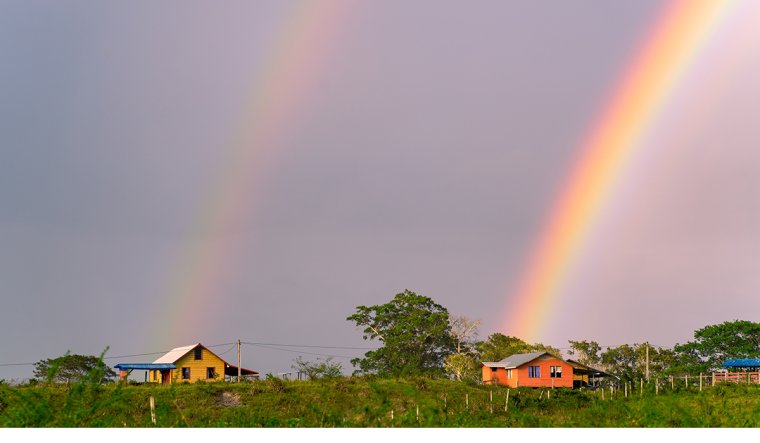In our Craft Capsules series, authors reveal the personal and particular ways they approach the art of writing. This is no. 185.
Can a poem become a body in motion? How about several bodies, a company of dancers moving about the page in synchronicity (sometimes not), taking up as much space as possible from the curtain to the scrim?
Why not reimagine the blank page as a stage for a performance to take place, where our personal joys and troubles can be expressed through language that leaps in front of the reader, even lunges at them?
What if the visual aspect of language is used to add emotional depth to a poem and becomes just as important as what we’re saying, adding to how we’re saying it?
My mother often tells this story from when I was three or four years old and my father had one of his musician friends over. They were listening to classical music in the living room. It was early nighttime, and my twin sister and I had just taken our baths. Our sweet mother had washed our hair and clipped it in buns on top of our heads, put our Lion King nightgowns on, and was just about to tuck us into bed. Somehow amid this bedtime ritual, I snuck downstairs, unclipped my long, wet hair, and started dancing with closed eyes and gesturing limbs to the dramatic music, with my father and his friend—and eventually my mother—looking on in astonishment at my innate need for and immediate expression of movement.
Though I have no recollection of this moment personally, this memory feels right to me. I started studying ballet shortly thereafter, gradually adding more dance classes until I was taking lessons nearly every weekday and training on the weekends. Throughout my adolescent years, I traveled from my home in Washington, D.C., to New York City during my summers to study at the Dance Theatre of Harlem and Alvin Ailey American Dance Theater.
All this is to say, my body has almost always been in motion, and that is what feels best to me: jumping, sliding, bending, arching, sweating, stretching, marking dance moves, running, tiredly walking. By the time I chose creative writing as my major in college, poetry could not be stagnant or static for me; it couldn’t always be left-aligned.
Imagining poetry as a linguistic dance performance that takes place on the space of the page can open the door for one’s creativity to explode, for the dispersing of energies as each word becomes a body shooting across the stage before the gathered and quiet audience, pushing us forward in both thought and feeling. A good deal of the poetry I’ve read and studied over the years uses only a tiny portion of each page, but a poem can fill up the entire page; it can mimic the movement of the human body or bodies (no matter the limitations or capabilities of the body doing the writing), enlivening the poet, the page, the poem, and the reader.
In choreography, the arrangement of dancers on stage and the quality of movement required of them create a world of action that contributes to the message or story being communicated to the audience, that core idea that is the impetus behind each look, arm gesture, or flexed foot. Generally speaking, though not always, it is the lack of language in dance, the patterns of bodies on stage—dancers moving into and away from one another, or exiting stage left for a duet to begin—that give the art form the capacity to touch us emotionally. As poets, we have the gift of words at our disposal; focusing on choreographing them, as opposed to merely writing them, allows us to attune more deeply to the buildup and release of tension and momentum that lies between those words, or lines of verse, both of which can be crammed together or pulled apart. Composing this way, making language more active than passive, can prompt the reader to wonder about the intimacy between words that have the pleasure of staying grouped together, about why other phrases are worlds apart, about the length of a line or the rush of the next one, words tumbling across or down the page, one after another.
The arrival of words in front of the reader’s eyes and their movement across the page do more than convey a literal message. They create an undercurrent to the work—I’m thinking of tectonic plates and how their movements reshape the Earth’s landscape—that is changing the continent of the poem: complicating it, subverting it, agreeing with it, pushing against it. This movement also says something about the music of the poem, it gives a tempo to the dance, a pulse affecting how someone will read your words; it tells the reader where the crescendo lies, where the bass and cello come in, and just how high the next note will be. In this way, we can achieve something multifaceted in choreographing language that isn’t entirely true for the choreography of bodies. In dance we often rely on music as the sonic backdrop for our movement, to complete and amplify the mood of a given piece. This music often dictates when and how we move our bodies. In poetry, language is both the dancers and the musicians; the more your words dance across the page, the more you are creating a musical score for your work (quite literally). The dance and music are one and the same, totally intertwined, for your words are jiving to the music that they are creating in real time, shimmying beside one another.
If you are, at this point in your reading, craving examples of such movement-based writing, stay with me for a while longer and see how far we can go without such literary leads. For the sake of remaining playful here (for this is what movement begs of us, to play and move and play and move until we absolutely must rest) and disrupting many of the academic ways of speaking about craft—if just for a moment—let’s not refer to another’s work as a way of learning how to create our own. Let’s start and move from within, from our own place of knowing and intuition. I will never forget my middle school English teacher and the one day he told us to write an essay on a book we had just finished reading as a class, but for the first time ever he gave us no question to prompt our essays. He made us independently choose what aspect of the text we wanted to write about and come up with a thesis from there. I complained to him after class that day, having admittedly no idea where to begin, and he responded by saying that we were all paralyzed by this freedom, yet constantly seeking liberation. So, with no literary references to guide you, try to allow this concept of language-as-dance and the page-as-the-stage to shake loose, unravel, and alter your understanding of how text can work for us; allow it to liberate your personal definition of what a poem is and how it can behave.
The best way to learn how to utilize the page entirely is to move your body gently, following it wherever it takes you in the air or on the floor, to dance in front of the mirror, to move with your siblings or close friends, to lie down and let your body melt into the carpet or wood or rug or bedding beneath you, to focus on your breathing with one hand over your stomach and the other over your heart, to attend a dance performance and sit at the highest point in the audience to see the small ant bodies moving and swirling about on stage below you, to take part in a yoga or Pilates or zumba or masala bhangra class. There are so many ways to write from an embodied place. Try jumping as high as you can for one whole minute or walking in lunges across the room, then writing from the soles of your feet or the soreness of your thighs. When you lay down to sleep at night, what part of your body feels relief or feels the blossoming of dull pain? Don’t ignore that; write from that, or even about that, and use that physical feeling as the impetus behind moving your language around until the (s)pacing feels authentic to all parts of you. In talking about craft, one can only set the stage for your idiosyncratic movements, patterns, and rhythms to reveal themselves to you through introspection and self-exploration.
This engagement with movement of the body can allow our minds—those often-rigid structures—to move and adapt as well, to form new neural pathways for exploring fresh ways of thinking and writing. That way, when we return to the page, we might have a more expansive understanding of how much space can be used and how fully utilizing that space can alter our work and move our readers. If you expand the body through movement, or expand your awareness through watching dance, you expand the possibilities for how you move your words on the page; you can uncage some necessary aspect of your creative self. The best way to choreograph language is to be fully in your body and your feelings, to experiment and play with language on the page, constantly trying to surprise yourself or actively do something you would normally never do to test your own understanding of what a poem can look like for you.
I’m remembering now all those cringe moments in high school when our contemporary dance teacher would turn off the lights in the studio and tell us to close our eyes and improvise to whatever song she put on next. I understand firsthand how repulsive exploration can be at times, how terribly vulnerable it is to get outside of one’s neat conception of who they are artistically, and to not move from a place of learned, textbook examples but instead from who you are at that moment in time.
With your stage now set and ready for you to enter as and when you please, let’s make a circular movement and finish as we started:
What if our performance of language became more fully embodied? What does that look like for you? How might that change your writing practice? How might it change your reading of the work, your relationship to the poem?
Is it uncomfortable? Is it freeing? Is it neither?
What is the emotional score of your poem as told through movement of the written word?
If the reader is your audience, then show them the true formations of your thoughts, show them how to feel you (beyond the heavy-duty, line-break work of poetry) pressed deeply into each individual letter and intentionally blank space on the page.
India Lena González is the features editor of Poets & Writers Magazine, a poet, and a multidisciplinary artist. Her debut poetry collection, fox woman get out!, was released this fall as part of BOA Editions’ Blessing the Boats Selections. India is also a professionally trained dancer, choreographer, and actor and has had the pleasure of performing at Lincoln Center, the Kennedy Center, St. Mark’s Church, La MaMa Experimental Theatre Club, New York Live Arts, and other such venues.
Art: Hulki Okan Tabak

















































